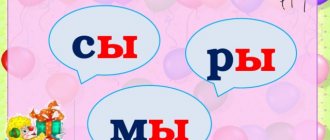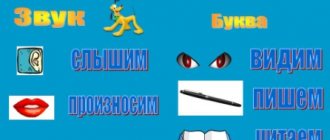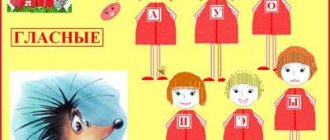Preparing for literacy training in preschool educational institutions
Research by linguists, psychologists, and teachers has shown that the fifth year of a child’s life is the period of the highest “linguistic giftedness” and special sensitivity to the sound side of speech. That is why it is necessary to introduce preschoolers to the sound system of their native language already from the middle group of kindergarten.
Secondary group training
is aimed at developing phonemic hearing and speech attention in children, which prepares them for mastering the sound analysis of words - the first step in teaching literacy itself.
Particular attention is paid to gaming techniques and didactic games, which constitute the specifics of teaching preschoolers and are an essential component of this training.
From March to May, the middle group conducts 10 classes to prepare for literacy. Duration 20 minutes.
Children gain knowledge about the basic laws of speech:
§ speech consists of words;
§ there are a lot of words, and they name objects, their characteristics, actions of objects and with objects;
§ words have length (long and short);
§ they sound (consist of sounds);
§ the word is linear (the sounds in it come one after another);
§ words can be used to make sentences;
§ sounds in words are pronounced differently (some can be drawn out, while others are pronounced briefly).
The only example of highlighting a certain sound in a word is the example of the teacher ( m
ak, luk
,
san
i
).
To play up the process of intonation selection, the sounds of a word are compared with the sounds of the surrounding life: with
- a big pump,
s
- a small one,
a
- a song of a beetle,
a
- a large mosquito,
a
- a small mosquito...
From the very beginning of training, the auditory distinction between hard and soft consonant sounds (little and big brother) is introduced.
Game task “Collect a bouquet”, the child takes a flower and lays it out on a flannelgraph, highlighting the first sound: r-r-daisy, r...
Children learn to write sentences using a "living model", taking on words, sentences about the children's actions, or various characters.
Didactic games:
§ “Children’s World”, “Zoo”, “Name the Words” - familiarization with the term “word”.
§ “Name the toy”, “Name the long word (short)” - long short words.
§ “Wind-breeze”, “The beetles have arrived”, “Whose song?”, “Pump” - introduction and consolidation of the term “sound”
§ “Say it like me”, “Echo”, “Name the first sound” - learn to distinguish sounds in words intonationally.
§ “Catch the end and continue” - the ability to isolate individual sounds in a word and name words with a given sound.
§ “Name your brother”, “Name the words”, “Be careful” - distinguishing hard and soft consonants by ear.
In the older group
children acquire the skills of sound analysis of words of various sound structures, differentiation of vowels, hard and soft consonants. They gain knowledge about the syllabic structure of words and word stress.
In the older group, teaching children the sound analysis of a word begins with determining the sequence of sounds in it. (Beetle, beetle, beetle). We use a picture diagram and chips to visually determine the number of sounds in a word. Don't forget about the intonation of sounds in a word.
After children have mastered the skills of conducting sound analysis of the simplest words, they are introduced to vowel sounds. Giving the characteristic that there is no obstruction in the mouth. We place our palm to our lips and determine that the air flows calmly. You can confuse children with the sounds s, l
. Let the children themselves prove why this is not so! We denote the vowel sound with a red chip. Comparing sounds in a fun way helps children learn the difference between vowels and consonants. They already know that there are big and little brothers, we introduce the designation with chips (blue and green).
We make sure to ensure the correct use of the terms “vowel sound”, “hard consonant sound”, “soft consonant sound”. In the process, children learn that the sounds have
and
sh
,
h
and
y
, there are no brothers.
It is difficult for children to become familiar with percussive sounds. Thanks to stress, the word is presented as a single whole and allows you to subsequently move from syllable-by-syllable reading to reading as a whole word. First, we isolate a stressed syllable with a two-syllable word with stress on the first syllable (bear, porridge).
The main thing is that the child understands that in order to determine the stressed syllable, there is no need to pronounce the word syllable by syllable. The stress falls on the vowel sound, because only the vowel can be drawn out and sung. The game “Try, Call” is that you need to call the word, stretching out the place with the accent, for example, ko-O-shka, za-A-yka, e-Yo-zhik. In the game “Repeat After Me,” say a certain word correctly, then shout it, and let the child shout the same. Then you whisper it and have him repeat it. In the third method, “Guess the riddle,” name the child familiar words, but with the wrong emphasis, let him guess what you named and pronounce correctly: “dog” - “dog”.
Another way: sit up straight. Fold your fists and place them on top of each other, with your chin on them. When the child reads (speaks) while pronouncing a stressed vowel, the chin will touch the fists.
In the process of learning to read and write, preschoolers become familiar with sentences. Learn to make sentences of 2-3 words. Children name the first, second... word in a sentence, change words in places, replace a word (Make a sentence).
Didactic games “Guess”, “Match the word to the diagram”, “Who lives in which house”, you need to correlate the name of the picture with the model of the word.
In the preparatory group
The following tasks are solved: children learn to analyze and synthesize sentences of different constructions, get acquainted with all the letters of the Russian alphabet and the rules for writing them, master syllabic and continuous reading methods, learn to correctly lay out words and sentences from the letters of the carved alphabet.
With the help of the “Living Model”, children make up sentences, determine the number of words, and replace words.
The work of conducting a sound analysis of a word necessarily includes isolating and marking the word stress against the background of a continuous pronunciation of the word while simultaneously holding a pointer under the laid out word.
One of the important tasks when conducting sound analysis of words is to familiarize children with vowel letters and the rules for writing them after hard and soft consonant sounds. (letters i, e, e, yu, and
– written after soft consonants,
a, o, e, u
– after hard consonants, the game “Guess what has changed?”).
Children look at each letter entered, say what it looks like, and become familiar with the small and capital letters. Let's find out and reinforce what a capital letter is for.
As we begin to familiarize ourselves with letters, we replace the chips in the diagrams with letters. Let's get acquainted with the rules of writing zhi, shi, cha, sha, chu, schu.
After several consonants, we get acquainted with ь. (chalk – chalk)…
With a letter separating function (Kolya-kolya) and with a softening function (coat-skates).
Separating function ъ
is revealed by comparing two words
(sat - ate).
To teach reading at the initial stage, we use the “windows” manual.
Word games are included in every lesson. Their main goal is to consolidate the acquired knowledge. They must be strictly regulated, while the accuracy and correctness of the teaching methodology must preserve the entertaining and emotional character inherent in games.
The ability of a teacher to arouse a child’s interest in his own activity, and not just transfer any knowledge to children, is an important component of the educational process. To support this interest, the teacher needs to use problematic situations in the educational process. The use of problem situations in working with preschoolers has a positive effect on the development of children's creative thinking, cognitive skills and abilities. Rubenstein S.L. said that “Thinking usually begins with a problem or question, with a contradiction. The problem situation determines the involvement of the individual in the thinking process.”
Teachers often have difficulty selecting problem situations. Techniques of visual, auditory, and motor clarity, entertaining and accessible questions for children, riddles, moments of surprise, surprise, mystery, and competition help to intensify mental activity.
Games used in educational activities and in individual work with students:
1.Isolating sound against the background of a word
| Name of the game | Target | Equipment | Progress of the game |
| "Where is the sound?" | Developing the ability to determine where sound is located. | Cards on which words are written, where the sound being studied is in different positions (beginning, middle, end of the word) | The teacher names the words, and the children must determine where the sound is located. |
| “Where is the sound hidden?” | Development of the ability to establish the place of sound in a word. | The teacher has a set of subject pictures; and for children - a card divided into three squares, each square depicting the place of a sound in a word. | The teacher shows the picture. Children name the object that is depicted and use a card to indicate the place of the sound in the words. |
| "Recognize the sound" | Development of skills to find words with the studied sound. | Cards with words for the teacher. | The teacher names the words, and the children clap their hands when a word with the sound being studied is heard. |
| "Highlight the sound" | Development of skills to highlight the first sound in a word. | A card with a riddle, and on the back there is a solution. | The teacher asks a riddle. The child pronounces the word and selects the first sound. If the child finds it difficult to guess the riddle, the teacher shows the answer. |
2. Setting the stress.
| Name of the game | Target | Equipment | Progress of the game |
| "Correct the mistake" | Developing the ability to put stress in words. | Cards with words (for the teacher). | Words are pronounced with incorrect and correct stress. The child listens carefully and corrects the mistake if there is one. For the correct answer - a chip. |
| "Let's Harvest" | Developing the ability to put stress in words. | Cards with images of vegetables and fruits; two baskets. | 2 teams. Each team takes a basket in which they will collect the harvest. The 1st team chooses cards with images of vegetables, the other - fruits. Children name the vegetable (fruit) and put the emphasis on it. If the emphasis is correct, then the vegetable (fruit) is placed in the basket. The team that harvests its crop the fastest wins. |
3. Isolation of the stressed syllable.
| Name of the game | Target | Equipment | Progress of the game |
| "Flowers" | Development of the ability to determine the number of syllables in a word. | Subject pictures (flowers). | On the teacher's desk there are pictures depicting flowers. Children need to first choose those that depict flowers with monosyllabic names, then those consisting of two or three syllables. |
| "Zoo" | Development of the ability to select with a given number of syllables. | Three pockets, on each there is a cage for animals, at the top - the syllabic structure of words; cards with pictures of animals. | The teacher says that new cages have been made for the zoo. Children are asked to determine which animals can be put in which cage. Children one by one go to the flannelgraph, take a card with a picture of an animal, name it, and use clapping to determine the number of syllables in a word. Based on the number of syllables, they find the cage for the named animal and put the card in the corresponding pocket. |
| "Wonderful bag" | Development of skills to divide words into syllables. | A fabric bag with various items, the names of which have 1,2,3 syllables. | Children come out in order, take an object out of the bag and name it. The word is repeated syllable by syllable, and children name the number of syllables in the word. The game is played like a competition. |
| "Buy a toy" | Development of the ability to determine the number of syllables in a word. | Toys: ball, doll, bear, car, pipe, dog, cubes. | The teacher lays out toys on the table and invites the children to “buy” those of them whose names have 2 syllables or 3 syllables. Children come to the table, choose a toy, and clearly pronounce the word syllable by syllable. If the answer is correct, the children take the toy. |
| "Silence" | Development of the ability to determine the number of syllables in a word. | Cards with numbers 1, 2, 3 (for each child). | The teacher names the word, and the children raise a card with a number corresponding to the number of syllables in this word. |
| "Syllable - step" | Development of the ability to select words with a given number of syllables. | The teacher gives each child the task: “Take two steps forward!”, “Take three steps forward!” The child must remember a word with as many syllables as the number of steps he is asked to take, and clearly pronounce it syllable by syllable so that each step corresponds to the pronunciation of one syllable. | |
| "One two Three" | Development of the ability to hear a syllable in a word. | Subject pictures, in the names of which the first, second, third syllable is stressed. | The pictures are displayed on a typesetting canvas. Each team receives one of the numbers 1, 2 or 3 and, accordingly, selects pictures with the first one. Second, third stressed syllable. Team representatives come out and take one picture each. The next child from the team leaves when the previous one sits down. The team that finishes the game faster and with fewer mistakes wins. |
| "Stressed syllable" | Strengthening the ability to highlight a stressed syllable. | Cards with words for the teacher. | The teacher tells the children words consisting of 1, 2, 3 syllables. Children's task: Identify and name the stressed syllable. |
| "Mystery" | Strengthening the ability to highlight a stressed syllable. | The teacher has cards with riddles and answers. | The teacher makes a riddle, and the children guess and find the answer on the typesetting canvas. Then the children are given the task: name only those guesses where the second, first, third syllable |
4. Differentiation of vowels and consonants.
| Name of the game | Target | Equipment | Progress of the game |
| "Find a place" | Consolidating knowledge about vowels and consonants. | Subject pictures; two circles: blue and red for each child. | Children lay out the pictures under a blue or red circle, depending on which. The name of the picture begins with a vowel or consonant sound. |
| "Who is bigger" | Consolidating knowledge about vowels and consonants. | Children are divided into several groups. The teacher asks each group to choose one vowel or consonant sound. When a sound is selected, children remember the names of objects that begin with that sound. The group that names the most words wins. | |
| "Find the object" | Consolidating knowledge about vowel sounds. | The teacher has object pictures. | The teacher has object pictures on the table, the children go out one at a time and choose a picture whose name has a vowel as the first sound. The child shows the card to the others, highlights the first sound, and the rest of the children check. |
| "Lotto" | Consolidating knowledge about vowels and consonants. | Lotto cards divided into three squares, each square contains a picture; blue and red stripes with which you will need to cover the subject pictures. | Children receive a card and four stripes (2 blue and 2 red). Children name the picture, highlight the first sound; if it is a vowel, it is covered with a red stripe, if it is a consonant, it is covered with a blue stripe. Whoever closes all the objects faster and more correctly wins. |
| “Find a place for the picture” | Consolidating knowledge about vowels and consonants. | House with pockets (blue and red); subject pictures. | The teacher has a stack of upside-down object pictures on his desk. Children go to the table one by one, take one picture, name the object depicted on it, identify the first sound, determine whether it is a vowel or a consonant, and then put the picture in the desired pocket (blue, red). The work continues until then. Until all the pictures are put in their places. |
| "Train" | Development of the ability to isolate vowel sounds. | Train with letters, subject pictures. | The teacher says that one day the animals decided to go to the city, but they don’t know who should go in which carriage. You must help them, highlight the vowel sound and put the animal in the carriage with that letter. |
| "Who Lives in the House" | Development of the ability to determine the presence of sound in a word. | House, a set of subject pictures. | Only those animals whose names contain the sound “o” live in the house. For the answer - a chip. |
5. A syllable as part of a word (for reading children).
| Name of the game | Target | Equipment | Progress of the game |
| "Shifters" | Development of the ability to compose words from syllables, accumulation of syllabic images in memory. | Cards with syllables for each child. | The teacher names two syllables separately. Children take cards with syllables and make one word from them, and then, rearranging the cards, make another. The one who can name which two words come out wins. |
| "Domino" | Development of the ability to compose words from syllables, accumulation of syllabic images in memory. | Each child has a domino plate and one for the teacher. | The teacher lays out his domino plate with the syllable “tra” and invites the children to choose the plate to make a word. Whoever finds the record first exhibits it. The game ends with the record empty. The one with the fewest records left wins. |
| "Watch" | Development of the ability to compose words from syllables, accumulation of syllabic images in memory. | Circle with moving arrows, set of syllable structures. | The first child places the hour hand on any syllable, the second child places the minute hand on another syllable to make a word. The game continues until all syllables are used. |
| "Chain" | Development of the ability to select words based on one given syllable. | One child names a word, for example: window, and pronounces it syllable by syllable; another child selects a word that begins with the last syllable of the previous word and also forms a word, etc. The winner is the one who last completed the chain. |




